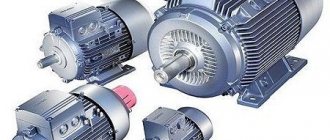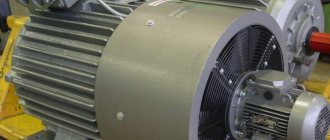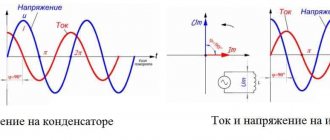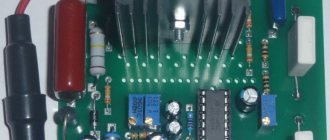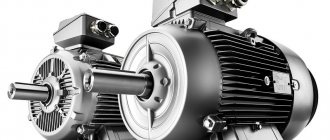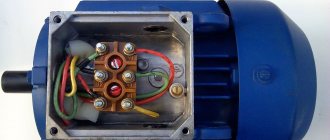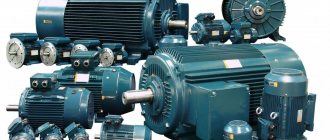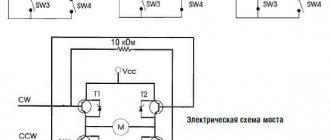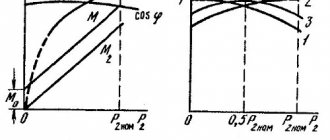Types of electric motors By type of supply current Synchronous electric motors Asynchronous electric motors Valve electric motors Power calculation Starting current calculation Operating modes Climatic version Energy efficiency
An electric motor is a mechanism that converts the energy of electric current into kinetic energy. It is difficult to imagine modern production and everyday life without electrically driven machines. They are used in pumping equipment, ventilation and air conditioning systems, electric vehicles, industrial machines of various types, etc.
When choosing an electric motor, you must be guided by several basic criteria:
- the type of electric current powering the equipment;
- electric motor power;
- operating mode;
- climatic conditions and other external factors.
DC and AC motors
Depending on the electric current used, motors are divided into two groups:
- DC drives;
- AC drives.
DC motors are not used as often today as they used to be. They have practically been replaced by asynchronous motors with squirrel-cage rotors.
The main disadvantage of DC electric motors is that they can only be operated with a DC source or an AC-to-DC converter. In modern industrial production, ensuring this condition requires additional financial costs.
However, with significant disadvantages, this type of motor is characterized by a high starting torque and stable operation under conditions of high overloads. Drives of this type are most often used in metallurgy and machine tool construction and are installed on electric vehicles.
The operating principle of AC electric motors is based on electromagnetic induction that occurs during the movement of a conducting medium in a magnetic field. To create a magnetic field, windings flowing around currents or permanent magnets are used.
AC electric motors are divided into synchronous and asynchronous. Each subgroup has its own design and operational features.
Engine types
Today, there are several main types of devices available on the electric motor market:
1. DC drive.
It is one of the most common types. This system is used in the metallurgical industry and transport, but the models are gradually being replaced by asynchronous devices.
The fact is that such a device has disadvantages - it can be used only if there is a certain current power that does not change during operation. To ensure such operating conditions, additional financial investments are required.
But there are also advantages - this type of system guarantees uninterrupted operation even under excessive loads.
2. AC drives.
These are products that can be divided into two types: synchronous and asynchronous. Each of these types has individual characteristics and characteristics, which are also worth paying attention to:
- Synchronous devices
are mainly used in devices that have a stable operating speed (generators, pumps). This type of system has high efficiency. Using synchronous electric motors you can minimize energy consumption. The system power can reach 10,000 kW, which not many can boast of. - Asynchronous motors
are unique devices. Their peculiarity lies in the high rates of rotation of the magnetic field, especially when compared with other devices. The equipment operates using alternating current, which is formed due to induction that occurs during the movement of a conductor medium in a magnetic field. In order for this to happen, specialists use a winding that flows around currents.
3. Valve devices.
This type includes devices in which special valves should be used to regulate the mode of use. Such units have a number of advantages:
- safety of use;
- ease of use;
- no need for additional care;
- high level of execution;
- the ability to adjust the rotation speed at your discretion.
Synchronous electric motors
Synchronous motors are the optimal solution for equipment with constant operating speed: DC generators, compressors, pumps, etc.
The technical characteristics of synchronous electric motors of different models differ. The rotation speed ranges from 125 to 1000 rpm, the power can reach 10 thousand kW.
The design of the drives includes a short-circuited winding on the rotor. Its presence allows for asynchronous engine starting. The advantages of equipment of this type include high efficiency and small dimensions. The operation of synchronous electric motors allows you to reduce electricity losses in the network to a minimum.
Asynchronous electric motors
Asynchronous AC motors are most widely used in industrial production. A feature of these drives is a higher frequency of rotation of the magnetic field compared to the speed of rotation of the rotor.
Modern engines use aluminum to make the rotor. The light weight of this material makes it possible to reduce the weight of the electric motor and reduce the cost of its production.
The efficiency of an asynchronous motor drops almost by half when operating at low loads - up to 30-50 percent of the nominal value. Another disadvantage of such electric drives is that the starting current parameters are almost three times higher than the operating parameters. To reduce the starting current of an asynchronous motor, frequency converters or soft starters are used.
Asynchronous motors meet the requirements of various industrial applications:
- For elevators and other equipment requiring stepwise speed changes, multi-speed asynchronous drives are produced.
- When operating winches and metalworking machines, electric motors with an electromagnetic braking system are used. This is due to the need to stop the drive and fix the shaft in case of power outages or disappearance.
- In processes with a pulsating load or in intermittent modes, asynchronous electric motors with increased sliding parameters can be used.
Knowledge of product and motor features
Manufacturers offer a wide range of electric motors for industrial applications. Stepper motors, servo motors, AC and DC motors are suitable for use in most types of industrial automation products, but the optimal choice of motor depends on the nature of the product. Users should select a motor for their product based on the required operating mode—constant speed, variable speed, or rotor position control—and in close consultation with the motor and drive suppliers.
Valve motors
The group of valve electric motors includes drives in which the operating mode is controlled by means of valve converters.
The advantages of this equipment include:
- High service life.
- Easy maintenance due to contactless control.
- High overload capacity, which is five times the starting torque.
- Wide speed control range, which is almost twice the range of asynchronous electric motors.
- High efficiency at any load - more than 90 percent.
- Small dimensions.
- Fast payback.
Motor power
A large number of mechanisms operate in constant or slightly varying load mode: fans, compressors, pumps, and other equipment. When choosing an electric motor, you need to focus on the power consumed by the equipment.
Power can be determined by calculation using the formulas and coefficients given below.
The power on the electric motor shaft is determined by the following formula:
where: Рм – power consumed by the mechanism; ηп – transmission efficiency.
It is advisable to choose the rated power of the electric motor greater than the calculated value.
Formula for calculating electric motor power for a pump
where: K3 – safety factor, it is equal to 1.1-1.3; g – free fall acceleration; Q – pump performance; H – lifting height (calculated); Y – density of the liquid pumped by the pump; ηus – pump efficiency; ηп – transmission efficiency.
Pump pressure is calculated using the formula:
Formula for calculating electric motor power for a compressor
The power of a piston compressor can be easily calculated using the following formula:
where: Q – compressor performance; ηk – indicator efficiency of a piston compressor (0.6-0.8); ηп – transmission efficiency (0.9-0.95); K3 – safety factor (1.05 -1.15).
The value of A can be calculated using the formula:
or take it from the table
| p2, 105Pa | 3 | 4 | 5 | 6 | 7 | 8 | 9 | 10 |
| A, 10-3 J/m³ | 132 | 164 | 190 | 213 | 230 | 245 | 260 | 272 |
Formula for calculating motor power for fans
where: K3 – safety factor. Its values depend on engine power:
- up to 1 kW – coefficient 2;
- from 1 to 2 kW – coefficient 1.5;
- 5 kW or more – coefficient 1.1-1.2.
Q – fan performance; H – outlet pressure; ηv – fan efficiency; ηп – transmission efficiency.
The given formula is used to calculate the power of axial and centrifugal fans. The efficiency of centrifugal models is 0.4-0.7, and that of axial fans is 0.5-0.85.
The remaining technical characteristics necessary to calculate engine power can be found in the catalogs for each type of mechanism.
IMPORTANT! When choosing an electric motor, there should be a power reserve, but it should be small. With a significant power reserve, the drive efficiency decreases. In AC motors, this also leads to a decrease in power factor.
The correct choice of engine power for the drive must meet the requirements of efficiency, productivity and reliability of the working machine. Installing an engine of greater power than required by the drive conditions causes unnecessary energy losses during machine operation, requires additional capital investments and an increase in engine dimensions. Installing an engine of insufficient power reduces the productivity of the working machine and makes its operation unreliable, and the engine itself can easily be damaged under such conditions.
The engine must be selected so that its power is used as fully as possible. During operation, the engine should heat up to approximately the maximum permissible temperature, but not higher than it. In addition, the engine must operate normally under possible temporary overloads and develop the starting torque required for a given working machine.
According to this, the engine power is selected in most cases based on the heating conditions (heating power selection), and then the compliance of the engine overload capacity with the machine starting conditions and temporary overloads is checked. Sometimes (with a large short-term overload) it is necessary to select a motor according to the required maximum power. Under such conditions, the engine's continuous power is often not fully utilized.
A. Selection of motor power for a drive with continuous operation. With a constant or slightly varying load on the shaft, the motor power must be equal to the load power. Checks for heating and overload during operation are not necessary. However, it is necessary to check whether the starting torque of the motor is sufficient for the starting conditions of the given machine.
The continuous load power of a number of well-studied mechanisms is determined on the basis of theoretical calculations proven in practice.
For example, motor power (kW) for a fan:
(1)
where V is the amount of forced or sucked air, m3/s;
∆р—difference, Pa;
ηven – coefficient of performance (efficiency) of the fan (for impeller fans 0.2 - 0.35, for centrifugal fans - up to 0.8);
ηper — transmission efficiency from the motor to the fan;
the product V∆р represents the useful power of the fan, and 1000 is the coefficient for converting power into kilowatts.
In many cases, the motor power of continuous-duty drives is calculated using empirical formulas that have been proven by long-term practice. For poorly understood continuous load drives, the motor power is often determined based on the specific energy consumption during production or experimentally by testing the drive.
B. Selection of engine power for short-term and intermittent operating modes. In short-term, repeated short-term and long-term modes with variable load, it is important to know the law of change over time in the excess of the engine temperature # above the ambient temperature.
From a heating point of view, an electric machine is a very complex body. Nevertheless, in calculations that do not require great accuracy, the electric machine can be considered a homogeneous body. This makes it possible to apply the simplified heating equation to it
(2)
where C is the heat capacity of the machine;
H - its heat transfer;
Q0 is the heat released in the machine per unit time.
At t = 0 the initial temperature rise is ? = ?o, so the constant A = temperature rise of the machine:
(3)
Thus, in this case, as in ???? =????o, the temperature rise increases exponentially, tending to the value
Figure 1. Initial temperature rise
The initial temperature rise changes only the rate of temperature change, but not the nature of the process (Figure 1).
For different values of continuous load of the same machine, the dependences ?(t) differ only in ordinates, Figure 2.
Figure 2. Temperatures under various continuous loads
The maximum permissible temperature rise for a given machine is ?nom. Direct? = ?mom, parallel to the abscissa axis, intersects the ?(t) curves at various points, corresponding to different values of the load power Pk of the electric motor. The abscissa of the intersection point determines the time period tk during which the engine power can be temporarily equal to the power Pk, which represents an overload in relation to its rated power in continuous mode. The heating curve approaching ?nom corresponds to the rated engine power Rnom.
At loads less than Rnom, the engine power is not fully used. However, if the engine is loaded for a relatively short time, then, in essence, it is also not fully used. It is advisable to overload it for a short time and the shorter the duration of operation, the greater this overload should be. The limit for increasing the motor load as the operating time decreases is determined by the instantaneous overload power of the motor, depending on its electrical properties (maximum torque for an asynchronous motor, switching conditions for DC machines, etc.).
In intermittent mode, the engine alternately heats up and cools down. The change in its temperature during each cycle depends on the previous thermal state. The dependence of heating and cooling of the machine on time under such conditions is shown in Fig. 3. The final temperature rise of each given part of the cycle is equal to the initial temperature rise for the subsequent part of the cycle. If during one or another part of the cycle there is a significant change in cooling conditions (engine stopping or a noticeable change in rotation speed), then the time constant T=C/H of engine heating changes, which must be taken into account when constructing graphs.
Figure 3. Dependence of heating and cooling of the machine on time
Determining engine power based on heating conditions by constructing heating graphs requires a significant amount of time and does not give accurate results. Here these constructions are presented only to clearly show the picture of changes in engine heating under variable load.
In most cases, simpler methods are used to select motor power, in particular the equivalent current method. This method is based on the assumption that under variable engine load, its average losses should be equal to losses under continuous (nominal) load.
The heating of the engine due to losses should be the same in both cases. On this basis we determine the equivalent current:
(4)
Knowing the equivalent current, rated voltage and rated power factor, you can determine the rated power of the motor:
(5)
The power of a three-phase electric motor is calculated using the following formula:
(6)
where: U-rated voltage;
I is the rated current of the electric motor (taken from the motor’s passport data, and in their absence, determined by calculation);
cosφ - power factor - the ratio of active power to total power (taken from 0.75 to 0.9 depending on the power of the electric motor);
η - efficiency factor (efficiency) - the ratio of the electrical power consumed by the electric motor from the network to the mechanical power on the motor shaft (taken from 0.7 to 0.85 depending on the power of the electric motor).
The result can be rounded to the nearest standard power value.
Standard values of electric motor power: 0.25; 0.37; 0.55; 0.75; 1.1; 1.5; 2.2; 3.0; 4.0; 5.5; 7.5; eleven; 15; 18.5; 22; thirty; 37; 45; 55; 75 kW, etc.
With a long-term constant load, the task of choosing the type of motor (DC, asynchronous, synchronous) is relatively simple. For such a drive, which does not require speed control, the PUE (Electrical Installation Rules) recommend using synchronous motors, regardless of power. This recommendation is explained by the fact that a modern synchronous motor starts up in the same way as an asynchronous one, and its dimensions are smaller and its operation is more economical than an asynchronous motor of the same power (higher cos????, higher maximum torque).
But if the electric motor must operate under conditions of controlled rotation speed, frequent starts, surges and load shedding, etc., then when choosing the type of motor it is necessary to compare the drive conditions with the peculiarities of the mechanical characteristics of various types of electric motors. It is customary to distinguish between natural and artificial mechanical characteristics of an engine. The natural mechanical characteristic corresponds to the nominal conditions of its activation, the normal connection diagram and the absence of any additional elements in the motor circuits. Artificial characteristics are obtained by changing the voltage on the engine, turning on additional elements in the engine circuit and connecting these circuits using special circuits.
An important criterion for assessing mechanical characteristics is their rigidity.
Stiffness may vary for individual sections of the characteristic.
Requirements for the rigidity of mechanical characteristics in some cases serve as the basis for choosing the type of engine. For example, a soft characteristic is desirable for hoisting and conveying mechanisms, while a very hard characteristic is required for cold steel rolling mills.
With frequent starts and variable loads, the most reliable and easiest to operate, and at the same time cheapest, is an asynchronous motor with a squirrel-cage rotor. A motor with a wound rotor is more expensive, its maintenance is more difficult, its dimensions are larger, and cos ? less (due to larger air gap).
The advantages of a wound rotor in terms of starting torque are negligible compared to a squirrel cage rotor having a double squirrel wheel. Therefore, motors with slip rings are installed only if there are special requirements for starting torque or starting current. Thus, for powers up to 100 kW with an unregulated drive, the most common is an asynchronous squirrel-cage motor. At high powers, if it is impossible to use a squirrel-cage asynchronous motor, an asynchronous motor with a wound rotor is installed.
Currently, the situation has changed significantly thanks to the introduction of power semiconductor converters. They make it possible to convert the frequency of alternating current, which allows you to smoothly and widely regulate the angular speed of the rotating magnetic field, and therefore, economically and smoothly regulate the rotation speed of asynchronous and synchronous motors. A DC motor costs significantly more, requires more maintenance, and wears out faster than an AC motor. Nevertheless, in a number of cases, preference is given to a DC motor, which allows simple means to change the rotation speed of the electric drive within a wide range (3: 1, 4: 1 and more).
As examples of drives for which direct current is recommended, we name the following: in the metallurgical industry - reversible rolling mills, adjustable non-reversible mills with multi-motor drives, auxiliary mechanisms for intermittent operation, blast furnace elevators; in the metalworking industry - special lathes.
The design (type) of the engine is selected depending on environmental conditions. It is necessary to take into account the need to protect the environment from possible sparks in the engine (in the presence of flammable dust, explosive mixtures, etc.), as well as the engines themselves from the ingress of moisture, dust, and aggressive chemicals from the environment.
The engine of the production unit must most fully meet the technical and economic requirements, i.e. be distinguished by simplicity of design, reliability in operation, lowest cost, small dimensions and weight, provide simple control, satisfy the peculiarities of the technological process and have high energy performance under various operating modes.
In unregulated drives of low and medium power, in most cases three-phase asynchronous motors with a squirrel-cage rotor are used, the design of which is coordinated with the necessary starting conditions of the production unit. If these motors cannot provide the starting conditions, three-phase asynchronous motors with a wound rotor are used, thanks to which it is possible not only to obtain an increased initial starting torque, but also to achieve its reduction to a given value. To drive medium and high power installations, it is advisable to use three-phase synchronous motors, which differ from similar three-phase asynchronous machines only in their higher efficiency (efficiency), but also allow power factor adjustment in order to compensate for the reactive power of all equipment.
In multi-speed drives that provide stepwise speed control, multi-speed three-phase asynchronous motors with a squirrel-cage rotor are used, allowing two, three or four rotor rotation frequencies to be obtained by switching in the stator winding circuit.
In adjustable drives with a smooth speed change in a small range, three-phase asynchronous motors with a wound rotor are used, and with a wide control range, DC motors with an appropriate excitation system are used, which determines the rigidity of the mechanical characteristics in accordance with the requirements of the production unit.
Thus, the type of motor current is entirely determined by the conditions of the technological process, and the voltage is selected in accordance with the standard supply voltages and taking into account the technical data of the motors.
For example, three-phase asynchronous motors of the 4A series with a rated power range from 0.06 to 0.7 kW are manufactured only for voltages of 220 or 380 V, with a range of 0.55 to 11 kW - for voltages of 220, 380 or 660 V, and with range from 15 to 110 kW - for voltages 220/380 or 380/660V.
If the rated power of the engine is in the range from 132 to 400 kW, then such engines are manufactured for voltages of 380/660V.
Three-phase asynchronous motors of other series with a rated power of over 200 kW are manufactured for voltages of 3, 6 and 10 kV. For DC motors of the 2D series with a rated power range from 0.37 to 200 kW at a rated speed of 1500 rpm, voltages of 110, 220, 380 and 440 V are accepted, and independent excitation voltage is 110 and 220 V. More powerful DC machines of other series are manufactured for higher voltages, which usually do not exceed 1500V.
Manufacturers produce open, protected and enclosed electric motors.
It is advisable to use open-type motors with large ventilation holes in the bearing shields and frame for better cooling conditions in a few cases: one has to take into account the ease of clogging of such a motor in a production environment from foreign objects, dust, moisture and dirt and the danger of electric shock to operating personnel when touching exposed live parts.
Protected-type engines have ventilation holes that are covered with grilles that protect the engine from raindrops, foreign particles, sawdust, etc., but not dust, from entering the engine. Such engines can be installed outdoors.
Enclosed engines are installed in dusty rooms in the presence of caustic fumes, etc., in the air. To improve the cooling of such engines, cooling air is blown through. The latter is supplied and discharged through special air ducts. In damp areas, protected motors with special moisture-resistant insulation are used. In explosive areas containing flammable gases or vapors, explosion-proof motors are installed.
Motor starting current
Knowing the type and rated power of the electric motor, you can calculate the rated current.
Rated current of DC motors
Rated current of three-phase AC motors
where: PH – rated power of the electric motor; UH is the rated voltage of the electric motor, ηH is the efficiency of the electric motor; cosfH is the power factor of the electric motor.
Rated power, voltage and efficiency values can be found in the technical documentation for a specific electric motor model.
Knowing the value of the rated current, you can calculate the starting current.
Formula for calculating the starting current of electric motors
where: IH – rated current value; Кп – direct current multiple to the rated value.
The starting current must be calculated for each motor in the circuit. Knowing this value, it is easier to select the type of circuit breaker to protect the entire circuit.
Operating modes of electric motors
The operating mode determines the load on the electric motor. In some cases it remains virtually unchanged, in others it may change. The nature of the expected load must be taken into account when choosing an engine. Current standards provide for the following operating modes:
Mode S1 (long-term). In this operating mode, the load remains constant for the entire time until the temperature of the electric motor reaches the required value. Drive power is calculated using the formulas given above.
Mode S2 (short-term). When operating in this mode, the engine temperature during its switching on does not reach the steady-state value. During shutdown, the electric motor cools down to ambient temperature. During short-term operation, it is necessary to check the overload capacity of the electric drive.
Mode S3 (periodically-short-term). The electric motor operates with periodic shutdowns. During periods of switching on and off, its temperature does not have time to reach the set value or cool down to the ambient temperature. When calculating engine power, the duration of pauses and losses during transition periods must be taken into account. When choosing an electric motor, an important parameter is the permissible number of starts per unit of time.
Modes S4 (periodically short-term, with frequent starts) and S5 (periodically short-term with electric braking). In both cases, the engine operation is considered according to the same parameters as in operating mode S3.
Mode S6 (periodically-continuous with short-term load). Operation of the electric motor in this mode involves operation under load, alternating with idling.
Mode S7 (intermittent-continuous with electric braking)
Mode S8 (periodically-continuous with simultaneous change in load and rotation speed)
Mode S9 (mode with non-periodic changes in load and rotation speed)
Most models of modern electric drives, which have been in operation for a long time, are adapted to changing load levels.
Electric motor selection criteria
The electric motor is environmentally friendly and reduces harmful emissions. If repairs are needed, they can be carried out with minimal investment, which makes the electric motor practical and versatile.
The choice of electric motor depends primarily on the area of application and intended purpose. If the equipment is designed for a pumping installation, it will not be suitable for a compressor or car.
Then you have to choose between models of different capacities and manufacturers.
The next indicator that an electric motor must meet is energy efficiency. The higher the energy consumption class, the faster the equipment will pay for itself, and the costs will be reduced in the future. This parameter is decisive when purchasing an electric motor.
In the Industrial Point online store you will find products from Siemens, IEK, WEG MOTOR, INNORED, INNOVARI and other companies. Convenient sorting by motor type simplifies your search and saves you time. Each electric motor is accompanied by a full description so that it is convenient to compare characteristics.
Criteria for selecting a suitable electric motor:
- name and category to which the drive belongs;
- power and number of operating modes;
- operating environment and intended purpose;
- operational and mechanical characteristics;
- options for adjusting the rotation speed and rotor position;
- the nature of the future load and additional requirements for equipment.
When selecting an electric motor, consider the application environment. If the load is constant, the maximum power on the drive shaft of the mechanism is important, and if not, the indicators of the moment of resistance over time. Evaluate the performance of the electric motor depending on the speed of rotation of the drive shaft.
Also pay attention to the magnitude of the starting torque, the speed control limits (upper and lower values), as well as the frequency of starts within one hour.
When purchasing an electric motor for common mechanisms, read the information provided by the manufacturer. In this case, it is enough to take into account the network requirements, the nature of the environment and the type of mechanism. Managers at the Industrial Point will answer questions and help you choose the appropriate electric motor model.
Climatic versions of electric motors
When choosing an electric motor, not only its technical characteristics are taken into account, but also the environmental conditions in which it will be operated.
Modern electric drives are available in different climatic versions. Categories are marked with corresponding letters and numbers:
- U – models for use in temperate climates;
- HL – electric motors adapted to cold climates;
- TS – versions for dry tropical climates;
- TV – versions for humid tropical climates;
- T – universal versions for tropical climates;
- О – electric motors for operation on land;
- M – engines for operation in marine climates (cold and temperate);
- B - models that can be used in any area on land and at sea.
The numbers in the model nomenclature indicate the type of its placement:
- 1 – possibility of operation in open areas;
- 2 – installation in rooms with free access of air;
- 3 – operation in closed workshops and premises;
- 4 – use in industrial and other premises with the ability to regulate climatic conditions (availability of ventilation, heating);
- 5 – versions designed for operation in areas of high humidity, with high condensation formation.
How to choose the right electric motor
When choosing an electric motor, consider the compliance of the working machine with all mechanical characteristics. There is no single instruction for this, but taking into account the specifics of the drive mechanism and environmental conditions, it is possible to find a suitable electric motor. The duration of trouble-free operation, efficiency and reliability will depend on the decision.
Please note that you have successfully chosen an electric motor if you were able to restore the operation of the fan, pump, machine or any other equipment for which it was intended. At the same time, energy consumption has not increased or become less, the work is done efficiently, and all the stated characteristics correspond to reality.
The task of the electric motor is to perform various types of movements. It can be precise, continuous or fast, with or without gear shifting. When choosing, take into account the future operating mode and the classification of drives according to all operating characteristics. For continuous operation without switching, you will need an asynchronous motor, if you need fast acceleration, you will need a synchronous one, and for precise positioning, you will need a stepper motor.
When choosing an electric motor based on power, you need to determine the nature of the impact that occurs on the equipment. Evaluate this indicator based on the rated load and changes in power consumption. The operating period of the drive can be short-term, long-term or intermittent. In the first case, there is no heating, and the equipment has time to cool down during shutdown. Drives of various mechanisms operate in this mode. In the second case, the equipment heats up to maximum values. This is typical for fans, pumps, conveyor belts, etc. Intermittent operation of the electric motor means that the mechanism is turned on at 15%, 25%, 40% and 60% for up to 10 minutes for each cycle. It is suitable for some machine tools, cranes, and welding generators.
Energy efficiency
Efficient energy consumption while maintaining high power reduces ongoing operating costs while increasing motor performance. Therefore, when choosing a drive, the energy efficiency class must be taken into account.
Technical documentation and catalogs must indicate the energy efficiency class of the engine. It depends on the efficiency indicator.
Experimental studies carried out in test and operating modes show that a 55 kW electric motor of high energy efficiency class reduces electricity consumption by 8-10 thousand kW annually.
Other useful materials:
Gearbox from “A” to “Z” How to choose a geared motor Selecting a frequency converter Connecting and setting up a frequency converter
Energy efficiency class
Currently, energy efficiency issues are receiving great attention. At the same time, energy efficiency refers to the rational use of energy resources, through which a reduction in energy consumption is achieved at the same level of load power. The main indicator of engine energy efficiency is its efficiency
where P2 is the useful power on the shaft, P1 is the active power consumed from the network.
The IEC 60034-30 standard for squirrel-cage asynchronous electric motors established three energy efficiency classes: IE1, IE2, IE3.
Rice. 1. Energy efficiency classes
For example, using a 55 kW motor with an increased energy efficiency class allows you to save about 8000 kW per year from one motor.

